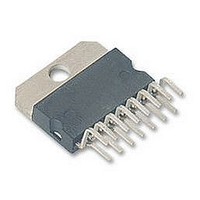LM1876TF National Semiconductor, LM1876TF Datasheet - Page 18

LM1876TF
Manufacturer Part Number
LM1876TF
Description
Audio Power Amplifier IC
Manufacturer
National Semiconductor
Specifications of LM1876TF
No. Of Channels
2
Amplifier Case Style
TO-220
No. Of Pins
15
Termination Type
Through Hole
Mounting Type
Through Hole
Peak Reflow Compatible (260 C)
No
Supply Voltage Max
22V
Lead Free Status / RoHS Status
Contains lead / RoHS non-compliant
Available stocks
Company
Part Number
Manufacturer
Quantity
Price
Part Number:
LM1876TF
Manufacturer:
NS/国半
Quantity:
20 000
Company:
Part Number:
LM1876TF/NOPB
Manufacturer:
RAYTHEON
Quantity:
334
www.national.com
Application Information
To achieve a transient free power-up and power-down, the
voltage seen at the input terminals should be ideally the
same. Such a signal will be common-mode in nature, and
will be rejected by the LM1876. In Figure 3, the resistor R
serves to keep the inputs at the same potential by limiting the
voltage difference possible between the two nodes. This
should significantly reduce any type of turn-on pop, due to an
uneven charging of the amplifier inputs. This charging is
based on a specific application loading and thus, the system
designer may need to adjust these values for optimal perfor-
mance.
As shown in Figure 3, the resistors labeled R
the LM1876 off the half-supply node at the emitter of the
2N3904. But due to the input and output coupling capacitors
in the circuit, along with the negative feedback, there are two
different values of R
resistors bring up the inputs at the same rate resulting in a
popless turn-on. Adjusting these resistors values slightly
may reduce pops resulting from power supplies that ramp
extremely quick or exhibit overshoot during system turn-on.
AUDIO POWER AMPLlFIER DESIGN
Design a 15W/8Ω Audio Amplifier
Given:
A designer must first determine the power supply require-
ments in terms of both voltage and current needed to obtain
the specified output power. V
equation (4) and I
To determine the maximum supply voltage the following
conditions must be considered. Add the dropout voltage to
the peak output swing V
current of I
Power Output
Load Impedance
Input Level
Input Impedance
Bandwidth
OPEAK
. The regulation of the supply determines
OPEAK
BI
, namely 10 kΩ and 200 kΩ. These
from equation (5).
OPEAK
OPEAK
, to get the supply rail at a
can be determined from
(Continued)
20 Hz−20 kHz
BI
1 Vrms(max)
help bias up
±
15 Wrms
0.25 dB
47 kΩ
8Ω
INP
(4)
(5)
18
the unloaded voltage which is usually about 15% higher. The
supply voltage will also rise 10% during high line conditions.
Therefore the maximum supply voltage is obtained from the
following equation.
For 15W of output power into an 8Ω load, the required
V
from adding V
supplies are
equation (5). It should be noted that for a dual 15W amplifier
into an 8Ω load the I
1.94 Apk or 3.88 Apk. At this point it is a good idea to check
the Power Output vs Supply Voltage to ensure that the
required output power is obtainable from the device while
maintaining low THD+N. In addition, the designer should
verify that with the required power supply voltage and load
impedance, that the required heatsink value θ
given system cost and size constraints. Once the heatsink
issues have been addressed, the required gain can be de-
termined from Equation (6).
From equation 6, the minimum A
By selecting a gain of 21, and with a feedback resistor, R
20 kΩ, the value of R
Thus with R
Since the desired input impedance was 47 kΩ, a value of 47
kΩ was selected for R
the bandwidth requirements which must be stated as a pair
of −3 dB frequency points. Five times away from a −3 dB
point is 0.17 dB down from passband response which is
better than the required
in a low and high frequency pole of 4 Hz and 100 kHz
respectively. As stated in the External Components sec-
tion, R
The high frequency pole is determined by the product of the
desired high frequency pole, f
A
which is less than the guaranteed minimum GBWP of the
LM1876 of 5 MHz. This will ensure that the high frequency
response of the amplifier will be no worse than 0.17 dB down
at 20 kHz which is well within the bandwidth requirements of
the design.
OPEAK
V
Max supplies ≈
= 21 and f
C
i
i
≥ 1/(2π
in conjunction with C
is 15.49V. A minimum supply rail of 20.5V results
i
±
OPEAK
= 1 kΩ a non-inverting gain of 21 will result.
H
*
26V and the required I
= 100 kHz, the resulting GBWP is 2.1 MHz,
1 kΩ
±
(V
and V
OPEAK
i
R
*
IN
OPEAK
follows from equation (7).
i
4 Hz) = 39.8 µF;
. The final design step is to address
±
= R
0.25 dB specified. This fact results
OD
drawn from the supplies is twice
f
i
. With regulation, the maximum
+ V
(A
create a high-pass filter.
H
V
, and the gain, A
OD
V
− 1)
is: A
) (1 + regulation) (1.1)
OPEAK
V
≥ 11.
use 39 µF.
is 1.94A from
SA
is feasible
V
. With a
(6)
(7)
f
=











